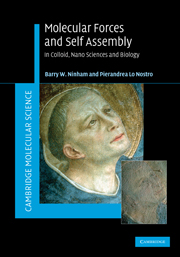Book contents
- Frontmatter
- Contents
- Preface
- Part I Molecular forces
- Part II Self assembly
- 9 Self assembly: overview
- 10 Self assembly in theory and practice
- 11 Bicontinuous phases and other structures: forces at work in biological systems
- 12 Emulsions and microemulsions
- 13 Forces at work: a miscellany of issues
- Index
- References
10 - Self assembly in theory and practice
from Part II - Self assembly
Published online by Cambridge University Press: 06 January 2011
- Frontmatter
- Contents
- Preface
- Part I Molecular forces
- Part II Self assembly
- 9 Self assembly: overview
- 10 Self assembly in theory and practice
- 11 Bicontinuous phases and other structures: forces at work in biological systems
- 12 Emulsions and microemulsions
- 13 Forces at work: a miscellany of issues
- Index
- References
Summary
Ideas and defects of theories of self assembly
As already remarked, the first attempts to build such a unified molecular theory of self assembly that could embrace all possible aggregates began 30 years ago.
It began with Tanford's ideas on opposing intramolecular forces between surfactant molecules at interfaces.
A theory via statistical mechanics was developed based on minimal assumptions. This theory is just a characterization of self assembly. It is more complicated than, but at the same level as, nucleation theory for gas–liquid phase transitions. (Nucleation theory considers only the growth of spherical aggregates, droplets of liquid in a vapour. With surfactants we have to consider a multitude of possible aggregates of different shapes.) Nonetheless, as we have seen, the characterization that emerged gave out a set of simple design rules to predict microstructure for dilute systems.
In outline the ideas involved are these:
In the processes involved in formation of an aggregate there are several factors that can be identified.
There is a hydrophobic free energy of transfer of a monomer surfactant hydrocarbon tail, from water to the assumed bulk oil-like environment in its associated state. In an aggregate at its interface the forces between the hydrocarbon tails oppose the intra-aggregate headgroup interactions (see Fig. 10.1). These forces could be ionic, hydration, zwitterionic or steric forces. This competition at the interface sets the interfacial curvature. There is then an interfacial free energy contribution augmented by curvature contributions.
- Type
- Chapter
- Information
- Molecular Forces and Self AssemblyIn Colloid, Nano Sciences and Biology, pp. 293 - 307Publisher: Cambridge University PressPrint publication year: 2010



